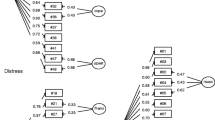Abstract
Despite the wide-spread use of Subjective Units of Discomfort Scales, or SUDS, to measure anxiety to specific stimuli, little information has been published on the validity of such scales and even less on their use as global measures of emotional and physical discomfort. Data was examined for 182 consecutive admissions to a psychology clinic to determine the relationship of self-rating of emotional and physical discomfort to one another and of the emotional self-rating to the clinician rating of general functioning (GAF). As expected, patients’ ratings of their emotional discomfort were significantly higher than ratings of their physical discomfort (t = 9.077, p < .001). Emotional SUDS were significantly and negatively related to clinicians’ GAF ratings (r = − 0.439, p < .001), indicating that the two ratings measured related global constructs. Data for the 53 patients who also completed the MMPI-2 was drawn from the larger sample to determine the nature of the relationship between SUDS and two measures of general emotional distress, with patients’ SUDS significantly related to both the A scale (r = 0.351, p < .05) and the neurotic index (r = 0.366, p < .01). Finally, there was a significant decrease in the emotional SUDS (t = 4.686, p < .001) but not the physical SUDS (t = 0.788, p = .434) after 3 months of psychotherapy. The data supports SUDS as global measures of both physical and emotional discomfort.
Similar content being viewed by others
References
American Psychiatric Association. (1994). Diagnostic and statistical manual of mental disorders (4th ed.). Washington, DC: APA.
Dahlstrom, W. G., Welsh, G. S., & Dahlstrom, L. E. (1972). An MMPI handbook. Vol. 1. Clinical interpretation (2nd ed.). Minneapolis: University of Minnesota.
Eimer, B. N., & Freeman, A. M. (1998). Pain management psychotherapy: A practical guide. New York: Wiley.
Endicott, J., Spitzer, R. L., Fleiss, J. L., & Cohen, J. (1976). The global assessment scale. Archives of General Psychiatry, 33, 766–771.
Freidenberg, B. M., Blanchard, E. B., Wulfert, E., & Malta, L. S. (2002). Changes in physiological arousal to gambling cues among participants in motivationally enhanced cognitive-behavior therapy for pathological gambling: A preliminary study. Applied Psychophysiology and Biofeedback, 27, 251–260.
Graham, J. R. (1993). MMPI-2. Assessing personality and psychopathology (2nd ed.). New York: Oxford University.
Greene, R. L. (2000). The MMPI-2. An interpretive manual (2nd ed.). Boston: Allyn and Bacon.
Griffin, M. G., Resick, P. A., & Mechanic, M. B. (1997). Objective assessment of peritraumatic dissociation: Psychophysiological indicators. American Journal of Psychiatry, 154, 1081–1088.
Harris, S. R., Kemmerling, R. L., & North, M. M. (2002). Brief virtual reality therapy for public speaking anxiety. Cyberpsychology and Behavior, 5, 543–550.
Jaycox, L. H., Foa, E. B., & Morral, A. R. (1998). Influence of emotional engagement and habituation on exposure therapy for PTSD. Journal of Consulting and Clinical Psychology, 66, 185–192.
Jones, N. F., & Holden, M. S. (1995). Mental health treatment and medical utilization: First pilot study in the military. Journal of Clinical Psychology in Medical Settings, 2, 269–274.
Kaplan, D. M., Smith, T., & Coons, J. (1995). A validity study of the subjective unit of discomfort (SUD) score. Measurement and Evaluation in Counseling and Development, 27, 195–199.
Kim, D., Bac, H., & Park, Y. C. (2008). Validity of the subjective units of disturbance scale in EMDR. Journal of EMDR Practice and Research, 2, 57–62.
Lohr, J. M., Kleinknecht, R. A., Conley, A. T., Dalcerro, S., Schmidt, J., & Sonntag, M. E. (1992). A methodological critique of the current status of eye movement desensitization (EMD). Journal of Behaviour Therapy and Experimental Psychiatry, 23, 159–167.
McCullough, L. (2002). Exploring change mechanisms in EMDR applied to “small-t trauma” in short-term dynamic psychotherapy: research questions and speculations. Journal of Clinical Psychology, 58, 1531–1544.
Richards, H. L., Ray, D. W., Kirby, B., Mason, D., Plant, D., Main, C. J., et al. (2005). Response of the hypothalamic-pituitary-adrenal axis to psychological stress in patients with psoriasis. British Journal of Dermatology, 153, 1114–1120.
Ruesch, J., & Bowman, K. M. (1945). Prolonged post-traumatic syndromes following head injury. American Journal of Psychiatry, 102, 145–163.
Shapiro, R. (1995). Eye movement desensitization and reprocessing. Basic principles, protocols, and procedures. New York: Guilford.
Thyer, B. A., Papsdorf, J. D., Davis, R., & Vallecorsa, S. (1984). Autonomic correlates of the subjective anxiety scale. Journal of Behaviour Therapy and Experimental Psychiatry, 15, 3–7.
Wilson, D. L., Silver, S. M., Covi, W. G., & Foster, S. (1996). Eye movement desensitization and reprocessing: Effectiveness and autonomic correlates. Journal of Behavior Therapy and Experimental Psychiatry, 27, 219–229.
Wolpe, J. (1958). Psychotherapy by reciprocal inhibition. Stanford, CA: Stanford University Press.
Wolpe, J., & Lazarus, A. A. (1966). Behavior therapy techniques: A guide to the treatment of neuroses. New York: Pergamon.



